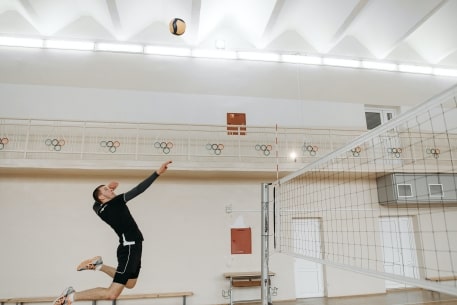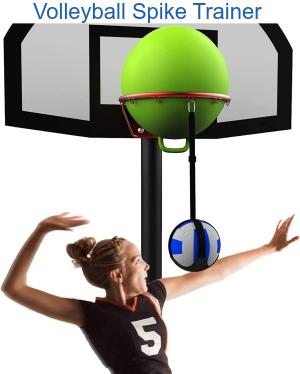Volleyball Opposite Hitter Drills
Volleyball is a team sport that requires a combination of skill, athleticism, and strategy. One of the key positions in the game is the opposite hitter, who plays an essential role in both offense and defense. To be an effective opposite hitter, one must possess a variety of skills, including hitting, blocking, serving, and digging. In order to improve these skills and become a dominant force on the court, it is essential to practice a variety of drills that target each aspect of the position. In this article, we will discuss some effective volleyball opposite hitter drills that can be incorporated into practice to help players develop their skills and reach their full potential.

Warm-Up Drills for Opposite Hitters
Before any training or practice, it is important to properly warm up the body to avoid injuries. Below are some warm-up drills that are specifically designed for opposite hitters:
Arm Swings
Arm swings are a great way to warm up the muscles in the arms and shoulders. To perform this drill, stand with your feet shoulder-width apart and swing your arms in a circular motion, starting with small swings and gradually increasing the size of the swings.
Footwork Drills
Footwork drills are crucial for developing quickness and agility on the court. Some examples of footwork drills include shuffle steps, cross-over steps, and figure-eight drills.
Hitting Drills for Opposite Hitters
Hitting is the most important skill for an opposite hitter. The following drills are designed to improve accuracy, power, and speed:
Cross-Court Hitting
Cross-court hitting is an essential skill for an opposite hitter. To perform this drill, stand on the right side of the court and hit the ball to the left side of the court, aiming for the far corner.
Line Hitting
Line hitting is another important skill for an opposite hitter. To perform this drill, stand on the left side of the court and hit the ball to the right side of the court, aiming for the sideline.
Cut Shot Hitting
Cut shot hitting is a more advanced skill that involves hitting the ball at an angle, dropping it just over the net and into the opponent’s court. This drill can be performed from various positions on the court and helps to develop both power and finesse.
Timing Drills
Timing drills are designed to help players develop their timing and coordination when hitting. One example of a timing drill is to have a partner toss the ball to the hitter at different apexes, requiring the hitter to adjust their approach and timing accordingly.
Off-Balance Hitting Drills
Off-balance hitting drills are designed to help players learn how to hit effectively even when they are off-balance. One example of an off-balance drill is to have the hitter jump off of one foot and hit the ball with the opposite hand.
Blocking Drills for Opposite Hitters
Blocking is another essential skill for an opposite hitter. The following drills are designed to improve blocking skills:
Solo Block Drills
Solo block drills are designed to help players improve their individual blocking skills. To perform this drill, have the hitter stand at the net and practice jumping and blocking the ball on their own.
Team Block Drills
Team block drills are designed to help players improve their blocking skills as a team. To perform this drill, have the opposite hitter and one or two other players stand at the net and practice jumping and blocking together.
Serving Drills for Opposite Hitters
Serving is an important skill for all players on the court, including opposite hitters. The following drills are designed to improve serving skills:

Jump Serve Drills
Jump serve drills are designed to help players develop the ability to jump and serve the ball with power and accuracy. To perform this drill, have the hitter jump and serve the ball over the net from various positions on the court.
Float Serve Drills
Float serve drills are designed to help players develop the ability to serve the ball with a low trajectory and minimal spin. To perform this drill, have the hitter practice serving the ball with a short toss and minimal arm movement.
Defensive Drills for Opposite Hitters
Opposite hitters also need to be able to play effective defense. The following drills are designed to improve defensive skills:
Digging Drills
Digging drills are designed to help players improve their ability to dig the ball when it is hit towards them. To perform this drill, have the hitter stand at the back of the court and practice digging balls hit towards them from various positions on the court.
Roll and Cover Drills
Roll and cover drills are designed to help players learn how to quickly recover and get back into position after making a dig. To perform this drill, have the hitter make a dig and then quickly roll and get back into position.
Game Situational Drills for Opposite Hitters
Game situational drills are designed to help players learn how to apply their skills in real-game situations. The following drills are designed to improve game situational skills:
Scrimmage Drills
Scrimmage drills are designed to simulate a real-game situation and help players apply their skills in a competitive setting. To perform this drill, have the team split into two and play a scrimmage with the opposite hitter playing their regular position.
End Game Drills
End game drills are designed to help players learn how to handle pressure situations at the end of a game. To perform this drill, have the team split into two and play a game where the opposite hitter is required to make the game-winning hit.
Conclusion
In conclusion, opposite hitter drills are essential for improving skills and becoming a dominant force on the court. By incorporating a variety of drills that target hitting, blocking, serving, defense, and game situational skills, players can develop a well-rounded skill set that will help them succeed in volleyball. It is important to implement these drills into regular practice sessions to see improvement over time.
FAQs


